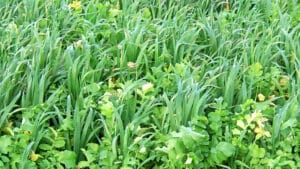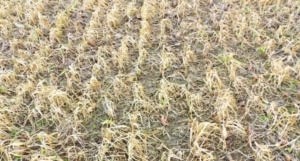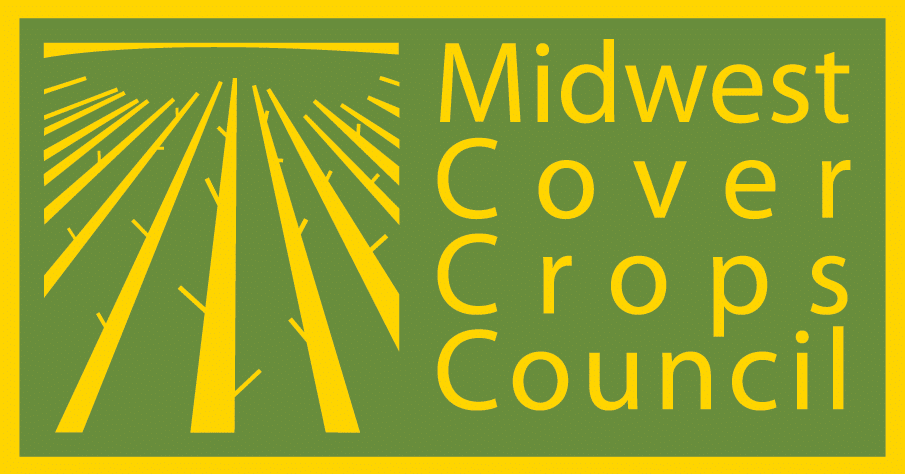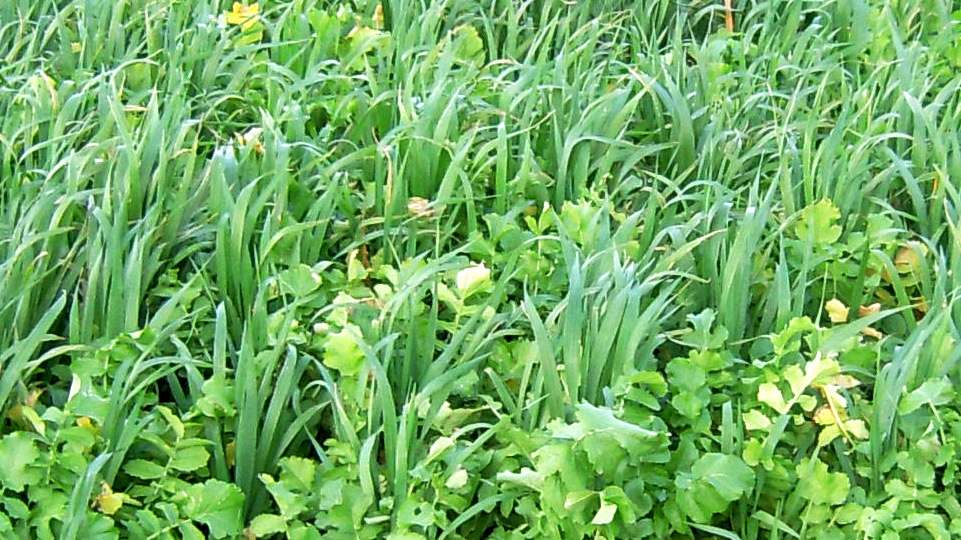Midwest Cover Crops Council (MCCC-117)
This publication is intended to provide a starting point for farmers who are new to growing cover crops. With experience, farmers may fine-tune the use of cover crops for their systems.
Introduction
The following recipe provides an introductory approach to integrating a cover crop into a soybean-corn rotation. Often the easiest place to begin is to plant a cover crop ahead of a soybean cash crop following corn, so consider starting with the companion recipe titled Post Corn, Going to Soybean (publication MCCC-116; see Resources).
Planning and Preparation
- Planning—Educate yourself. Start small. Be timely. Prioritize management based on your purpose and objectives.
- Soybean variety and planting—If possible, plant the preceding soybean crop early and use an early maturity soybean cultivar. One strategy is to use your earliest-maturity-group soybeans on the fields where you plan to seed cover crops and plant those beans first.
- Residual soybean herbicides—Because oats are very tolerant of most soybean residual herbicides, few restrictions apply unless grazing is being considered. Radish is more sensitive and will likely be harmed if ALS-type (group 2) or PPO-type (group 14) herbicides are used in the soybean cropping season. (See Resources.)
- Seed purchase—Order cover crop seed early. Named oat varieties grow well but are more expensive than VNS (variety not stated) seed. Start with VNS seed with a good germination rate purchased from a reputable seed dealer. Note that this means the seed has been cleaned and has a certified lab-tested germination tag. Spring barley may be more expensive but can be used instead of oats. For cover crop radishes (daikon type), be sure to purchase a single variety from a reputable seed dealer. Seeding rate calculations are based on one of two factors: pure live seed (PLS) or seed count. The Natural Resources Conservation Service (NRCS) calculations for Ohio are based on pure live seed for compensation.
Fall Work
- Soybean harvest—Harvest fields where a mix of spring oats/radish are to be planted as early as possible.
- Timing of planting—Ideally, plant oats/radish immediately after harvest. In most of Ohio, this should occur by the third week in September. See Selector Tool (in Resources section) for more precise dates for your county.
- Planting method—Drill to a depth of 0.25–0.50 inch or broadcast, but note that incorporation of the seed, if any, should be light since excessive disturbance of soybean stubble may negate any benefit of the cover crop. For more details on seeding methods, visit the MCCC website.
- Seeding rate in oats/radish mix—Drilled: oats, 30–60 lbs./acre PLS; radish, 2–4 lbs./acre PLS. Broadcast: oats, 33–60 lbs./acre PLS; radish, 3–5 lbs./acre PLS. (See Calculating Pure Live Seed section below.)
- Aerial seeding or overseeding—An alternative to seeding after harvest is to do aerial seeding with a plane or helicopter or overseeding with a ground-based vehicle. In most of Ohio, seeding should take place in late August or by the first week of September and before 25% of the soybean leaves have yellowed and dropped. Rainfall after seeding is essential for establishment.
- Seeding rate for overseeding—For oats: 40–60 lbs./acre PLS; for radish: 4–6 lbs./acre PLS.
- Tillage or no-tillage—To allow for adequate cover crop growth, it is best if no full-width tillage takes place until spring, after the oats/radish have been killed by freezing temperatures. It is best to maintain surface cover to prevent erosion and nutrient runoff.
- Fertility or liming—If applying P, K, or lime, complete the application prior to the seeding operation or apply to the growing oats/radish before the ground freezes. If it is necessary to inject N fertilizer or manure in the fall, a low-disturbance applicator should be used to minimize the reduction in surface residues.

Spring Work
- Starter fertilizer—Strongly consider equipping your corn planter with 2×2 starter fertilizer, and aim for a starter fertilizer rate between 30–50 pounds of actual nitrogen (N) per acre. Extra nitrogen is needed in the spring to decompose the additional cover crop residue.
- Scouting—If corn color is light green or slightly off-color, N deficiency may be an issue and extra N should be applied. Tissue test for N sufficiency. Scout for true armyworm, cutworm, slug, and vole damage.

Calculating Pure Live Seed
Pure live seed (PLS) indicates the amount of seed in the container that is capable of developing into seedlings. To calculate PLS, the percentage of pure seed listed on the seed label of a cultivar is multiplied by the percent germination (also listed on the seed label). For example: 90% pure seed of the cultivar x 80% germination = 72% PLS.
To determine how much seed to plant, divide 100 by the percentage PLS (72 in this example): 100 ÷ 72 = 1.4. Therefore, 1.4 pounds of seed with a purity of 90% and a germination of 80% would be needed for each pound specified in the desired seed mixture.
Resources
Post Corn, Going to Soybean: Use Cereal Rye (Ohio Cover Crop Recipe series, MCCC-116)
Herbicide Rotation Restrictions in Forage and Cover Cropping Systems (University of Wisconsin Extension publication)
Calculating the Price of Pure Live Seed (PennState Extension website)
Cover Crop Selector Tool —available from Midwest Cover Crops Council
Using Cover Crops to Convert to No-till (Ohio State University Extension Fact Sheet SAG-11)
Understanding Soil Microbes and Nutrient Recycling (Ohio State University Extension Fact Sheet SAG-16)
Authors
Sarah Noggle, Ohio State University Extension; and James J. Hoorman, Hoorman Soil Health Services (Note: This publication was adapted with consent from MCCC under a joint project to produce customized introductory guidance about cover crops for all member states/provinces.)
Reviewers and Contributors
Jason Hartschuh, Ohio State University Extension; Eileen Kladivko, Purdue University; Anna Morrow, Midwest Cover Crops Council; Eric Richer, Ohio State University Extension; Alan Sundermeier, Ohio State University Extension
The Midwest Cover Crops Council (www.https://www.midwestcovercrops.org) aims to facilitate widespread adoption of cover crops throughout the Midwest by providing educational/outreach resources and programs, conducting new research, and communicating about cover crops to the public.
Funding for this project was provided by McKnight Foundation.
January 2020
The U.S. Department of Agriculture (USDA) prohibits discrimination in all its programs and activities on the basis of race, color, national origin, age, disability, and where applicable, sex, marital status, familial status, parental status, religion, sexual orientation, genetic information, political beliefs, reprisal, or because all or a part of an individual’s income is derived from any public assistance program. (Not all prohibited bases apply to all programs.) Persons with disabilities who require alternative means for communication of program information (Braille, large print, audiotape, etc.) should contact USDA’s TARGET Center at (202) 720-2600 (voice and TDD). To file a complaint of discrimination write to USDA, Director, Office of Civil Rights, 1400 Independence Avenue, S.W., Washington, D.C. 20250-9410 or call (800) 795-3272 (voice) or (202) 720-6382 (TDD). USDA is an equal opportunity provider and employer. ©2020 by MCCC. All rights reserved.

